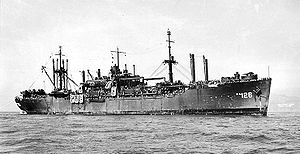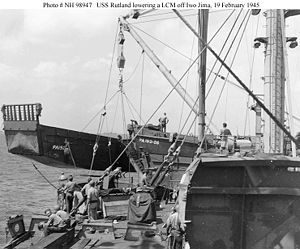
Haskell class attack transport
Encyclopedia
Haskell-class attack transport
s (APA) were amphibious assault ship
s of the United States Navy
created in 1944. They were designed to transport 1,500 troops and their combat equipment, and land them on hostile shores with the ships' integral landing craft
.
The Haskells were very active in the World War II Pacific Theater of Operations
, landing Marines and Army troops and transporting casualties at Iwo Jima
and Okinawa
. Ships of the class were among the first Allied
ships to enter Tokyo Bay
at the end of World War II, landing the first occupation troops at Yokosuka. After the end of World War II, most participated in Operation Magic Carpet, the massive sealift
of US personnel back to the United States. A few of the Haskell class were reactivated for the Korean War
, with some staying in service into the Vietnam War
.
The Haskell-class design, Maritime Commission standard type VC2-S-AP5, is a sub‑type of the World War II Victory ship
design. 117 Haskell-class ships were launched in 1944 and 1945, with 14 more being finished as another VC2 type or canceled.
The Haskells carried 25 landing craft to deliver the troops and equipment right onto the beach. The 23 main boats were the 36 feet (11 m) long, LCVP
. The LCVP was designed to carry 36 equipped troops. The other 2 landing craft were the 50 foot (15 m) long LCM (3), capable of carrying 60 troops or 30 tons (27 t) of cargo, or the 56 foot (17m) LCM (6). They also carried one gig
.
The Haskell-class ships were armed with one 5"/38 caliber gun, twelve Bofors 40 mm gun
s (one quad mount, four dual mounts), and ten Oerlikon 20 mm guns
.
 Haskell class attack transports included APA-117, , the lead ship
Haskell class attack transports included APA-117, , the lead ship
, through APA-247, the never completed . The hulls for APA-181 through APA-186 were repurposed to be hospital ship
s before they were named. Ultimately those hospital ships were built on larger C4 plan
and the six VC2 hulls were built in a merchant configuration. APA-240 through APA-247 were named, but cancelled in 1945 when the war ended. With the special exception of the , the Haskell-class ships were all named after counties of the United States
.
s.
As of the 28 February 2011 MARAD
inventory, there is only one ship built as Haskell-class left in the inventory:
The , the last remaining ship in the Haskell configuration was scrapped in 2009 at ESCO Marine, in Brownsville, Tx.

Attack transport
Attack Transport is a United States Navy ship classification.-History:In the early 1940s, as the United States Navy expanded in response to the threat of involvement in World War II, a number of civilian passenger ships and some freighters were acquired, converted to transports and given hull...
s (APA) were amphibious assault ship
Amphibious assault ship
An amphibious assault ship is a type of amphibious warfare ship employed to land and support ground forces on enemy territory by an amphibious assault...
s of the United States Navy
United States Navy
The United States Navy is the naval warfare service branch of the United States Armed Forces and one of the seven uniformed services of the United States. The U.S. Navy is the largest in the world; its battle fleet tonnage is greater than that of the next 13 largest navies combined. The U.S...
created in 1944. They were designed to transport 1,500 troops and their combat equipment, and land them on hostile shores with the ships' integral landing craft
Landing craft
Landing craft are boats and seagoing vessels used to convey a landing force from the sea to the shore during an amphibious assault. Most renowned are those used to storm the beaches of Normandy, the Mediterranean, and many Pacific islands during WWII...
.
The Haskells were very active in the World War II Pacific Theater of Operations
Pacific Theater of Operations
The Pacific Theater of Operations was the World War II area of military activity in the Pacific Ocean and the countries bordering it, a geographic scope that reflected the operational and administrative command structures of the American forces during that period...
, landing Marines and Army troops and transporting casualties at Iwo Jima
Battle of Iwo Jima
The Battle of Iwo Jima , or Operation Detachment, was a major battle in which the United States fought for and captured the island of Iwo Jima from the Empire of Japan. The U.S...
and Okinawa
Battle of Okinawa
The Battle of Okinawa, codenamed Operation Iceberg, was fought on the Ryukyu Islands of Okinawa and was the largest amphibious assault in the Pacific War of World War II. The 82-day-long battle lasted from early April until mid-June 1945...
. Ships of the class were among the first Allied
Allies of World War II
The Allies of World War II were the countries that opposed the Axis powers during the Second World War . Former Axis states contributing to the Allied victory are not considered Allied states...
ships to enter Tokyo Bay
Tokyo Bay
is a bay in the southern Kantō region of Japan. Its old name was .-Geography:Tokyo Bay is surrounded by the Bōsō Peninsula to the east and the Miura Peninsula to the west. In a narrow sense, Tokyo Bay is the area north of the straight line formed by the on the Miura Peninsula on one end and on...
at the end of World War II, landing the first occupation troops at Yokosuka. After the end of World War II, most participated in Operation Magic Carpet, the massive sealift
Sealift
Sealift is a term used predominantly in military logistics and refers to the use of cargo ships for the deployment of military assets, such as weaponry, vehicles, military personnel, and supplies...
of US personnel back to the United States. A few of the Haskell class were reactivated for the Korean War
Korean War
The Korean War was a conventional war between South Korea, supported by the United Nations, and North Korea, supported by the People's Republic of China , with military material aid from the Soviet Union...
, with some staying in service into the Vietnam War
Vietnam War
The Vietnam War was a Cold War-era military conflict that occurred in Vietnam, Laos, and Cambodia from 1 November 1955 to the fall of Saigon on 30 April 1975. This war followed the First Indochina War and was fought between North Vietnam, supported by its communist allies, and the government of...
.
The Haskell-class design, Maritime Commission standard type VC2-S-AP5, is a sub‑type of the World War II Victory ship
Victory ship
The Victory ship was a type of cargo ship produced in large numbers by North American shipyards during World War II to replace shipping losses caused by German submarines...
design. 117 Haskell-class ships were launched in 1944 and 1945, with 14 more being finished as another VC2 type or canceled.
Design
The VC2-S-AP5 design was intended for the transport and assault landing of over 1,500 troops and their heavy combat equipment. During Operation Magic Carpet, up to 1,900 personnel per ship were carried homeward.The Haskells carried 25 landing craft to deliver the troops and equipment right onto the beach. The 23 main boats were the 36 feet (11 m) long, LCVP
LCVP
The Landing Craft, Vehicle, Personnel or Higgins boat was a landing craft used extensively in amphibious landings in World War II. The craft was designed by Andrew Higgins of Louisiana, United States, based on boats made for operating in swamps and marshes...
. The LCVP was designed to carry 36 equipped troops. The other 2 landing craft were the 50 foot (15 m) long LCM (3), capable of carrying 60 troops or 30 tons (27 t) of cargo, or the 56 foot (17m) LCM (6). They also carried one gig
Captain's Gig
The captain's gig is a boat used on naval ships as the captain's private taxi. It is a catchall phrase for this type of craft and over the years it has gradually increased in size, changed with the advent of new technologies for locomotion, and been crafted from increasingly more durable...
.
The Haskell-class ships were armed with one 5"/38 caliber gun, twelve Bofors 40 mm gun
Bofors 40 mm gun
The Bofors 40 mm gun is an anti-aircraft autocannon designed by the Swedish defence firm of Bofors Defence...
s (one quad mount, four dual mounts), and ten Oerlikon 20 mm guns
Oerlikon 20 mm cannon
The Oerlikon 20 mm cannon is a series of autocannons, based on an original design by Reinhold Becker of Germany, very early in World War I, and widely produced by Oerlikon Contraves and others...
.
Ships of the Haskell class

Lead ship
The lead ship or class leader is the first of a series or class of ships all constructed according to the same general design. The term is applicable military ships and larger civilian craft.-Overview:...
, through APA-247, the never completed . The hulls for APA-181 through APA-186 were repurposed to be hospital ship
Hospital ship
A hospital ship is a ship designated for primary function as a floating medical treatment facility or hospital; most are operated by the military forces of various countries, as they are intended to be used in or near war zones....
s before they were named. Ultimately those hospital ships were built on larger C4 plan
Type C4 ship
The Type C4 class ship were the largest cargo ships built by the United States Maritime Commission during World War II. The design was originally developed for the American-Hawaiian Lines in 1941, but in late 1941 the plans were taken over by the MARCOM.Seventy-five ships were built as cargo and...
and the six VC2 hulls were built in a merchant configuration. APA-240 through APA-247 were named, but cancelled in 1945 when the war ended. With the special exception of the , the Haskell-class ships were all named after counties of the United States
County (United States)
In the United States, a county is a geographic subdivision of a state , usually assigned some governmental authority. The term "county" is used in 48 of the 50 states; Louisiana is divided into parishes and Alaska into boroughs. Parishes and boroughs are called "county-equivalents" by the U.S...
.
- See List of Haskell-class attack transports.
Fate
Most of the Haskell-class ships were mothballed in 1946, with only a few remaining in service. Many of the Haskell-class were scrapped in 1973-75. A few were converted into Missile Range Instrumentation ShipMissile Range Instrumentation Ship
Missile Range Instrumentation Ships, Range Ships, or Tracking Ships, are ships equipped with antennas and electronics to support the launching and tracking of missiles and rockets...
s.
As of the 28 February 2011 MARAD
Marad
Marad was an ancient Sumerian city. Marad was situated on the west bank of the then western branch of the Upper Euphrates River west of Nippur in modern day Iraq and roughly 50 km southeast of Kish, on the Arahtu River.The city's ziggurat E-igi-kalama was dedicated to Ninurta the god of...
inventory, there is only one ship built as Haskell-class left in the inventory:
- The , which was converted to - She is in the National Defense Reserve FleetNational Defense Reserve FleetThe National Defense Reserve Fleet consists of "mothballed" ships, mostly merchant vessels, that can be activated within 20 to 120 days to provide shipping for the United States of America during national emergencies, either military or non-military, such as commercial shipping crises.The NDRF is...
at James River, Virginia. Her status is listed as "Disposal".
The , the last remaining ship in the Haskell configuration was scrapped in 2009 at ESCO Marine, in Brownsville, Tx.


